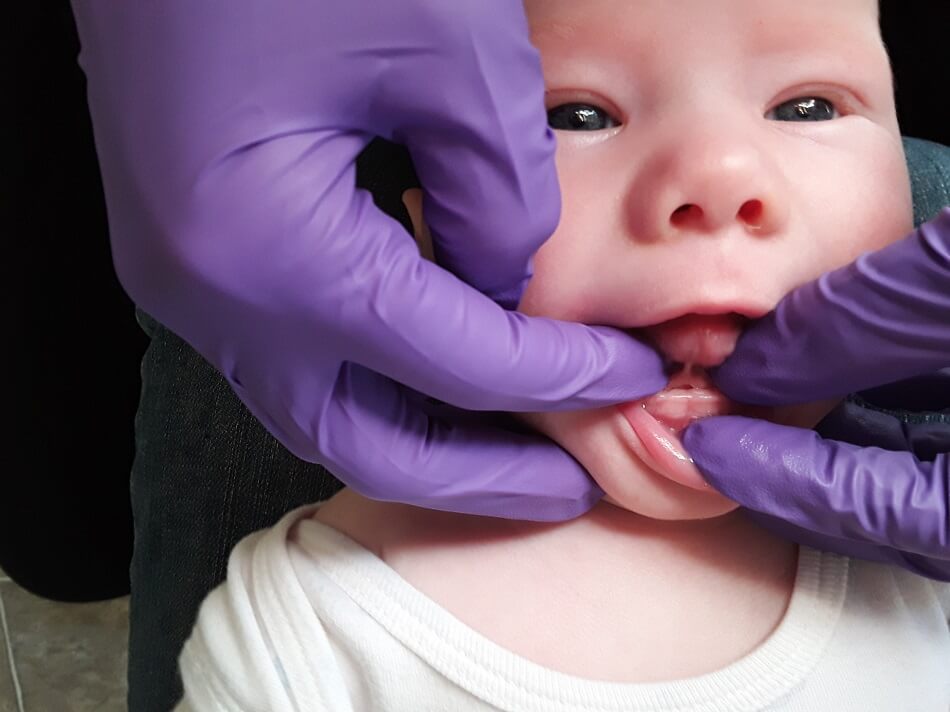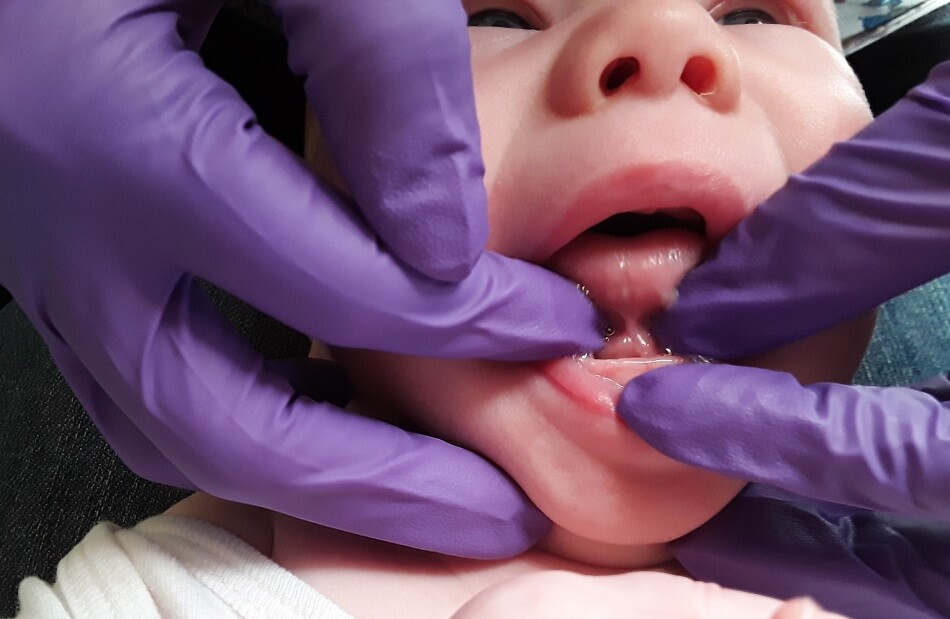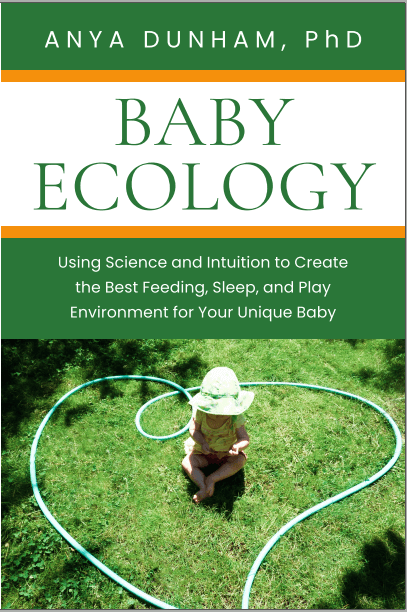Baby Ecology book is here! Learn more
Baby Ecology book is here!
- Home
- Baby-led feeding
- Tongue tie
Tongue tie baby feeding challenges
by Anya Dunham, PhD
Summary of research and our experience with tongue tie baby feeding challenges, to help you compile a list of questions for your baby’s health care practitioner.

You’re probably wondering – and worrying – whether your baby has a tongue tie, whether you need to do anything about it, and how to overcome tongue tie baby feeding challenges. These questions are close to my heart because my three babies were born with tongue ties.
I must begin by saying that I have a PhD in Biology (my training and background), but I am not a medical professional. I wrote this article to summarize research on tongue tie in babies that I have found and to share some of my family’s experiences. I hope this helps you come up with a list of questions to ask your baby’s healthcare practitioners – and to continue looking for answers if you don’t get them right away or receive confusing or conflicting advice.
What are tongue ties?
A tongue tie, or ankyloglossia, means that the baby’s frenulum — the membrane under his tongue — is unusually thick, tight, or short, restricting the tongue’s movement.1 Tongue ties are reported in 3 to 16% of babies, but the true percentage may be higher because not all cases are documented.1,2.
Some things to remember:
- Every baby has a frenulum, and its shape and size varies from one baby to another.
- Assessing a baby for a tongue tie requires a comprehensive evaluation by an experienced professional.
- A thorough evaluation includes assessing not just tongue appearance but also function; not all babies whose tongues appear restricted experience feeding challenges.
Tongue ties are not a new phenomenon - but the prevalence of tongue tie feeding challenges may be
At present, there is much less research on tongue ties than there is on other infant feeding topics. Does this mean tongue ties are new, a fad or an old wives’ tale?
It appears to be neither. Some babies have historically been born with tongue ties and feeding challenges. My niece’s pediatrician mentioned casually that in the past, midwives used to keep one nail long and sharp to snip ties in newborns. I have found at least one record to corroborate this. In A Young Wife’s Guide in the Management of her Children written way back in 1764, John Theobald noted: “it may be necessary to cut the bridle of the tongue and this is usually done by nurses and midwives with their nail.”3
As time went on, hygiene and medical standards went up, which is undeniably a good thing. But also, bottle-feeding became the norm in many western countries due to promotion of formula-feeding in the 19th century. And so ties were no longer clipped with a nail, but seemingly became less of an issue, as most, though not all, babies with ties could still bottle-feed effectively.
Then in the 1990s breastfeeding rates went up – and tongue tie feeding challenges became a more prominent and better recognized issue.
Advice on tongue ties is often conflicting
Although most lactation consultants agree that tongue ties tend to cause breastfeeding difficulties, not all pediatricians do. Many medical guidelines don’t specify whether tongue ties need to be treated. Because of this, families often receive conflicting advice on whether their baby has a tongue tie and whether frenotomy is recommended.1,4
In 2020, an expert panel of pediatric otolaryngologists from the American Academy of Otolaryngology–Head and Neck Surgery published a clinical consensus statement on tongue and lip ties.5 (Full text)
Also in 2020, the Australian Dental Association, in association with an expert multidisciplinary panel of health professionals, has developed the "Ankyloglossia and Oral Frena Consensus Statement". (Full text)
It can be challenging to reconcile conflicting advice.
My three babies were seen, combined, by 3 different pediatricians and 5 board-certified lactation consultants. For two babies we received a mix of opinions on the best path forward. For one baby, both pediatricians and a lactation consultant recommended a tongue tie revision.
Tongue tie baby feeding challenges
Babies with tongue ties may experience a variety of feeding challenges.
To breastfeed, a baby needs to be able to open his mouth wide and bring his tongue down and out over the bottom lip to draw in the nipple and areola to latch, creating vacuum-like pressure. Many babies with tongue ties cannot create a vacuum as they latch onto the breast. Some babies cannot latch at all; others can but are not very efficient at extracting milk because of decreased tongue mobility. Breastfeeding mothers often experience nipple pain and damage, breast pain, and mastitis.1
Our early tell-tale sign for all three babies included audible clicking sounds (from baby slipping off the breast due to shallow latch, regardless of positioning) and ‘milk’ blisters (from baby trying to maintain a seal using their lips). All three babies still gained weight well in the early weeks.
Sometimes, tongue tie feeding challenges are not apparent at birth. When a breastfeeding mother has ample milk and a strong milk ejection reflex, a baby might get sufficient milk in the early weeks passively, by milk sort of ‘fire hosing’ into baby's mouth. But this mode of feeding relies on milk flow rather than on active transfer by the baby. Once milk supply naturally regulates and the flow slows down around 4-8 weeks, babies may begin to struggle with feeding and weight gain.
This was the case for one of my babies. My oversupply created an opportunity for him to feed passively, so he gained weight very well in the early weeks. However, he appeared to be swallowing quite a bit of air and showed symptoms of reflux. Once my supply downregulated, his weight gain slowed down considerably.
It appears that there may be a connection between tongue ties and reflux symptoms, at least in some babies. Siegel (2016)6 describes a phenomenon called ‘aerophagia induced reflux’ (AIR). A retrospective analysis of questionnaire/intake surveys of 1,000 babies over 5 years in a private surgical practice showed a correlation between aerophagia in babies with ties and reflux. After a surgical revision of tongue and lip ties, 520 (52%) babies showed improvement or complete reversal of symptoms of reflux, 283 (28.3%) had no change in reflux, and 191 (19.1%) showed improvement in post-feed irritability and less reflux symptoms but were not successfully weaned off reflux medications. Slagter et al (2021)7 also report an improvement in reflux symptoms in babies 1 and 6 months after tongue tie revision.
So, as I mentioned, tongue ties are not a new phenomenon, but the recognition of a problem is, and research does not appear to have caught up quite yet. There are still unanswered questions and uncertainties. Existing research mostly concentrates on the safety and effectiveness of frenotomy.
Research suggests tongue tie revision (frenotomy) is generally safe and effective
Frenotomy (also called ‘frenulotomy’ and tongue tie ‘division’, ‘release’, and ‘revision’) is a small surgical procedure in which the frenulum is cut.
How safe is frenotomy? Hale et al (2020)8 reported an average annual incidence of 13.9 cases of complications per 100,000 frenotomies in New Zealand, with a peak of 85.6 complications per 100,000 frenotomies in one region. (In total, the authors recorded 16 complications, most of which required hospital admission, over 2 years of surveillance. Complications included poor feeding (7 cases), respiratory events (4 cases), pain and bleeding (3 cases each) and weight loss (3 cases).) A Cochrane review of 5 small studies reported no adverse outcomes of frenotomy.9
How effective is frenotomy? Hogan (2005)10 reported that in babies with tongue ties, frenotomy was more effective in resolving improper latch than improving feeding position or adjusting feeding frequency. Several other studies stated that frenotomy made breastfeeding more comfortable, improved milk production, and led to more efficient feedings.1,11,12 However, in most of these studies the assessments were qualitative, because somethings like comfort level is, of course, subjective and challenging to measure.
A Cochrane review I mentioned above9 that included 5 randomized trials (with 302 babies in total) reported a reduction in breastfeeding mothers’ nipple pain in the short term and “an inconsistent positive effect on infant breastfeeding” (generally positive effects but no definitively proven benefit). The review highlighted methodological shortcoming of the five trials: small sample sizes in all studies; in only two studies12,13 both mothers and assessors were unaware of whether the revision was performed or not (i.e. ‘blinded’); and no study was able to report whether frenotomy led to long‐term successful breastfeeding. This is at least in part due to the fact that babies in the control group (those who didn’t initially get the frenotomy) were offered the procedure shortly after it became apparent that frenotomy had positive effects in the treatment group – and so long-term comparisons became impossible. The review concluded with the need for more research on this topic.
Getting the best possible answers for your baby
Figuring out whether your baby has a tie requires a close examination by an experienced professional – someone (or several people) who can see the whole picture.
Checking for ties is not always done at birth or during well-baby visits; there may or may not be routine screening where you live. In some countries lactation consultants can refer you to a specialist for assessment and surgical intervention; in others you’ll need a referral from your family doctor or pediatrician.
Remember that every baby has a frenulum, and that frenulum shape and size varies from one baby to another. Breastfeeding success depends not only on baby’s tongue mobility but also other aspects of baby’s oral anatomy as well as breastfeeding mother’s anatomy.14
Sarah Oakley, RN, IBCLC writes in Why Tongue-tie Matters14: “... the explosion in numbers of divisions being reported … has lead to concerns being raised about over-treatment, particularly in the USA and Australia. When I first started dividing tongue-ties in 2011, I rarely had a baby attend who didn’t have an obvious, significant tongue-tie. Now at least a fifth of the babies that come to me for division either do not have a tongue-tie or have a very mild restriction with minor feeding difficulties which can be resolved with conservative strategies. … Anyone referring babies for division or performing tongue-tie division needs expertise in infant feeding and tongue-tie assessment, or should be working alongside someone who has.” (emphasis mine)
See how Sarah Oakley assesses baby’s tongue movement: video
It’s important to assess not only baby tongue’s appearance, but also its function.5,15 A pediatric dentist we saw said that function – assessed through an account of parents’ experience and an observation of baby’s tongue movement and feeding – is the most important factor he considers.
 This tie is easy to see. Baby's tongue was tight and had a characteristic heart shape. However, the assessment of function was still important.
This tie is easy to see. Baby's tongue was tight and had a characteristic heart shape. However, the assessment of function was still important.We decided to not revise the ties of our two babies for whom we received conflicting advice from the pediatricians and lactation consultants. For both, we focused on improving latch with positioning. They both exclusively breastfed for the first 6 months and continued to breastfeed until 13 and 20 months. Our third baby – for whom our pediatrician, lactation consultant, and pediatric dentist all recommended a tongue tie revision – received a revision at 4 months. I believe the revision helped his latch and lessened, but didn't fully resolve, his reflux symptoms. He exclusively breastfed for the first 5.5 months and continued to breastfeed until 26 months.
Considering the whole picture, not just tie classification or appearance
You might have heard that there are different types, grades or classes of tongue ties. Based on what I have read, it is not important for parents to know exactly what type of tie baby has and whether that type of tie is typically revised or not. It is much more important to find the right support – experienced professionals – who will help you understand how your baby’s tongue functions and if/how this affects feeding.
I hope this information and our experience have given you some food for thought.
Don’t stop if the initial advice you receive is conflicting; continue looking for help until you feel fully heard and supported. Your baby’s health, comfort, and mastery in feeding – and your comfort and peace of mind – are valid and important.
You might also be interested in:
References
References
1. Edmunds J, Miles S, Fulbrook P (2011) Tongue-tie and breastfeeding: a review of the literature. Breastfeeding Review 19(1): 19-26
2. Ingram J, Johnson D, Copeland M, Churchill C, Taylor H, Amond A (2015) The development of a tongue assessment tool to assist with tongue-tie identification. Arch Dis Child Fetal Neonatal Ed 100(4): F344-8
3. Cullum IM (1959) An old wives’ tale. British Medical Journal 2(5150): 497–498 (full text: https://www.ncbi.nlm.nih.gov/pmc/articles/PMC1990346/?page=1)
4. Messner AH, Lalakea ML (2000) Ankyloglossia: controversies in management. International Journal of Pediatric Otorhinolaryngology 54(2-3): 123-31
5. Messner AH, Walsh J, Rosenfeld RM, et al. (2020) Clinical consensus statement: ankyloglossia in children. Otolaryngology–Head and Neck Surgery 162(5): 597-611
6. Siegel SA (2016) Aerophagia induced reflux in breastfeeding infants with ankyloglossia and shortened maxillary labial frenula (tongue and lip tie). International Journal of Clinical Pediatrics 5(1): 6-8
7. Slagter KW, Raghoebar GM, Hamming I, Meijer J, Vissink A (2021) Effect of frenotomy on breastfeeding and reflux: results from the BRIEF prospective longitudinal cohort study. Clin Oral Investig 25(6): 3431-3439
8. Hale M, Mills N, Edmonds L, Dawes P, Dickson N, Barker D, Wheeler BJ (2020) Complications following frenotomy for ankyloglossia: A 24-month prospective New Zealand Paediatric Surveillance Unit study. J Paediatr Child Health 56(4): 557-562
9. O'Shea JE, Foster JP, O'Donnell CPF, Breathnach D, Jacobs SE, Todd DA, Davis PG (2017) Frenotomy for tongue‐tie in newborn infants. Cochrane Database of Systematic Reviews 2017, Issue 3. Art. No.: CD011065
10. Hogan M, Westcott C, Griffiths M (2005) Randomized, controlled trial of division of tongue-tie in infants with feeding problems. Journal of Paediatrics and Child Health 41: 246-250
11. Segal LM, Stephenson R, Dawes M, Feldman P (2007) Prevalence, diagnosis, and treatment of ankyloglossia. Methodologic Review. Canadian Family Physician 53(6): 1027-1033
12. Berry J, Griffiths M, Westcott C (2012) A double-blind, randomized, controlled trial of tongue-tie division and its immediate effect on breastfeeding. Breastfeeding Medicine 7(3): 189-193
13. Dollberg S, Botzer E, Grunis E, Mimouni FB (2006) Immediate nipple pain relief after frenotomy in breast-fed infants with ankyloglossia: a randomized, prospective study. J Pediatr Surg 41(9): 1598-600
14. Oakley S (2021) Why tongue-tie matters. Pinter and Martin, UK
15. Ricke LA, Baker NJ, Madlon-Kay DJ, DeFor TA (2005) Newborn tongue-tie: prevalence and effect on breast-feeding. The Journal of the American Board of Family Practice 18(1): 1-7
Using hundreds of scientific studies, Baby Ecology connects the dots to help you create the best environment for sleep, feeding, care, and play for your baby.
Warmly,
Anya


